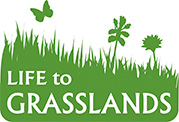The project LIFE TO GRASSLANDS will contribute to the achievement of the Natura 2000 Management Programme (2015-2020), while it addresses the most endangered species and habitat types, of which the status in this area needs to be improved. One of the project’s challenges is to seek possibilities for the re-cultivation of abandoned agricultural lands and thus “bring life back to the grasslands”. In this way, it can show that providing food security and the security of nature can go hand in hand. If we enable life to grasslands, the latter will even ensure our own survival.
The planned project activities:
- Identification of areas that are becoming overgrown, analysis of the agricultural use and monitoring of the status of the habitat types;
- Communication and networking with the owners of the land and the farmers with the purpose of providing management of abandoned lands;
- Lease and redemption of abandoned lands (and further rental of the land in accordance with the deal) to ensure continuous management of grasslands;
- Elimination of overgrowth/clearing of the land in various phases of overgrowth;
- Ensuring continuous management of grasslands by guiding and offering support (procurement of equipment and machines) on the basis of the agreements reached with the owners and the lessees.
- Renewal and establishment of grasslands with extensive tall-trunk orchards (procurement of saplings and protective equipment, planting and education about maintenance);
- Connecting farmers with the purpose of providing management of cleared areas and surfaces that are inappropriately used;
- Preparation of plans for agricultural holdings for the selected – interested farms;
- Preparation of technical basis for the agricultural environmental programme from the field of continuous management of grasslands for individual areas, which will be submitted to the Ministry of Agriculture, Forestry and Food and to the Ministry of the Environment and Spatial Planning, with the purpose of improving the programme with KOP OP measures and adjusting the latter in accordance with the characteristics of individual regions;
- Activities and the plan to establish the trademark and the products connected to dry grasslands, orchards, grazing and mowing (workshops, marketing, promotion);
- Promotional and educational activities – co-operation and programmes/accessories for schools, education for farmers, municipalities, communication with decision makers from the field of agriculture and the environment on the national level, equipment of interpretation and info points, complementation of existing interpretation routes, publications;
